Ordering Fractions and Mixed Numbers
Comparing rational numbers expressed in fractional notation makes it possible to locate the numbers in relation to each other. They can then be placed in ascending or descending order.
For a complete understanding of the material in this section and to know how to order numbers in fractional notation, it is important to remember the types of fractions and the method used to express a fraction as a mixed number and vice versa. It is also necessary to understand equivalent fractions and simplification methods.
Representation of the Order of Rational Numbers That are Expressed Using Fractional Notation
There are several ways to represent the order of rational numbers that are expressed using fractional notation. The following is one method.
Parts of a Whole
A picture of a whole divided into equal parts is often used to represent a fraction. This representation can also be used to demonstrate the order of fractions.
Which of the following is the greater fraction?
3478
This situation can be represented using two figures separated into equal parts.
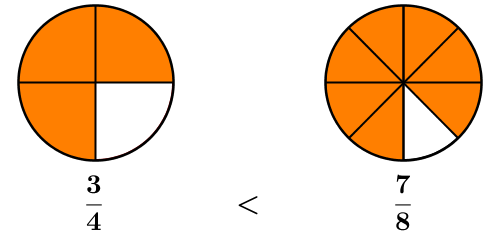
Note that 78 is greater than 34. To prove it, ensure that both fractions have the same denominator, then compare the numerators. The result is the following.
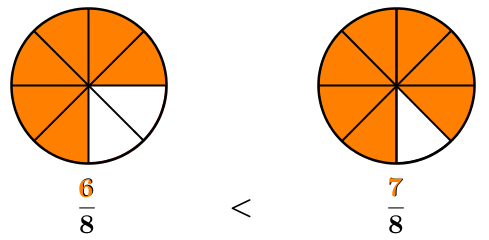
Important!
Once they have the same denominator, the greater fraction is the one with the larger numerator.
The same representation can be used to order mixed numbers.
Which mixed number is greater? 123134
This situation can be represented using the following figures.
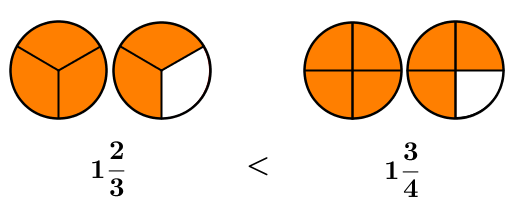
Note that 134 is greater than 123. To prove it, ensure that the fraction part of each mixed number is over the same denominator.
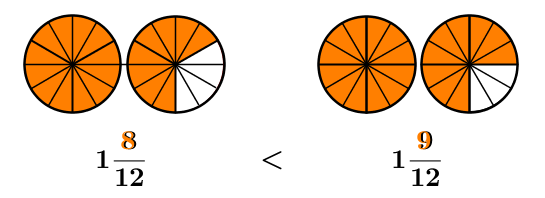
Important!
When comparing two mixed numbers with the same integer part, only the fractional part needs to be compared. Once the mixed numbers have the same denominator, the greater mixed number is the one with the larger numerator.
If two mixed numbers do not have the same integer part, the greater one is automatically the one that has the larger whole number part. For example:
134<234
Methods for Ordering Rational Numbers That are Expressed Using Fractional Notation
There are a few methods for ordering rational numbers that are expressed using fractional notation. Two methods are outlined below.
Method 1: Using a Common Denominator
Finding a common denominator allows you to put the numbers in order, as follows.
Rule
-
Convert mixed numbers into fractions where necessary.
-
Determine the common denominator for all the fractions.
-
Convert the initial fractions into equivalent fractions with the common denominator.
-
Put the fractions in the desired order, relying on the numerators only.
-
Return the fractions to their original form.
Tip
To determine the common denominator of all fractions, the LCM method can be used. In fact, the denominators’ LCM becomes their common denominator.
Place the following fractions in ascending order. 183471012
-
Convert mixed numbers into fractions where necessary
Since there are no mixed numbers, move on to the next step. -
Determine the common denominator for all the fractions by finding the LCM
The LCM is the following. LCM(8,4,10,2)=40 The common denominator is 40. -
Convert the initial fractions into equivalent fractions with the common denominator
1×58×5=5403×104×10=30407×410×4=28401×202×20=2040 -
Put the fractions in the desired order, relying on the numerators only
The ascending order of the numerators results in the following. 540 < 2040 < 2840 < 3040 -
Return the fractions to their original form
By returning the fractions to their initial form, the desired order is obtained. 18 < 12 < 710 < 34
The process is the same when there are negative fractions.
Place the following rational numbers in descending order. 113−12−561312
-
Convert mixed numbers into fractions where necessary
Converting 113 into a fraction gives this result. 113⇒43 -
Determine the common denominator for all the fractions by finding the LCM
The LCM of the denominators is the following. LCM(3,2,6,12)=12 The common denominator is 12. -
Convert the initial fractions into equivalent fractions with the common denominator
4×43×4=1612−1×62×6=−612−5×26×2=−10121312=1312 -
Put the fractions in the desired order, relying on the numerators only
Placing these fractions in order means placing their numerators in order. To do this, we proceed as we do for integers. Therefore, the decreasing order is the following. 1612 > 1312 > −612 > −1012 -
Return the fractions to their original form
113 > 1312 > −12 > −56
When you have negative fractions, it may be better to use a number line to put them in order.
Method 2: Using a Number Line
In order to use this method, it is essential to know how to place numbers expressed as fractions on a number line.
Important!
To place a fraction on a number line, the line must be divided into as many equal parts as the fraction's denominator.

For example, consider the fraction 23. The fraction is between 0 and 1. Since the denominator of the fraction is 3, we will have to divide the space between 0 and 1 into 3 equal parts.

The fractions’ numerator will then indicate its position on the number line.

If there is an improper fraction (fraction bigger than 1), divide each whole unit as necessary on the number line. Consider the fraction 54. Because the denominator is 4, each whole unit on the number line is divided into 4 equal parts. Next, use the numerator to indicate its place on the number line.

In the case of a mixed number, proceed in much the same way. However, instead of starting from 0, start from the integer part of the mixed number.
For the mixed number 312, divide the space between 3 and 4 into two equal parts.

The procedure is similar for negative fractions and negative mixed numbers.

Once the position of each number expressed using fractional notation is located on a number line, the line can then be used to order the numbers.
Rule
-
Place each of the numbers expressed in fractional notation on a number line.
-
Place the numbers in the desired order, knowing that the further to the right a number is, the greater it is.
Place the following rational numbers in ascending order.
951221334
-
Place each of the numbers expressed in fractional notation on a number line
By properly dividing the number line, the numbers can be positioned as follows.
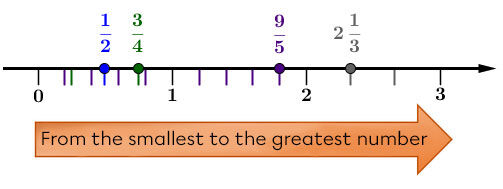
-
Place the numbers in the desired order, knowing that the further a number is to the right, the greater it is
The result is the following ascending order.
12 < 34 < 95 < 213
We proceed in the same way with negative rational numbers that are expressed using fractional notation.
